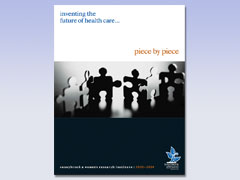Spotlight on Breast Cancer Research: Aiming for a Biological Bull's-Eye
Picture a dartboard. Pick up an imaginary dart and toss it at the dartboard. Where does it land? If you're like most people and me, you probably hit the board, but well outside the bull's-eye, an apt metaphor for where treatment is in breast cancer. That is, treatments like chemotherapy and drugs are having a real impact, saving lives even, but they are far from being targeted and effective for women at all stages of breast cancer. And the largely one-size-fits-all dosing means many women deal with painful side effects and the disease.
Dr. Arun Seth is a molecular biologist at SWRI. Through his work in genomics, the study of genes and their function, he is trying to solve these problems. "Once we know what's happening in the cell, which genes are involved in cancer, then we can develop therapies that are more targeted and mechanism-based," says Seth, who also heads SWRI's Centre for Genomics.
The work is painstaking. Because it happens at the level of molecules, even the most encouraging results are a ways off from helping patients. Nonetheless, the work is foundational. Without it, the dream of targeted therapies remains just that.
Seth is examining the molecules inside tumour cells at each stage of breast cancer to identify patterns, including which are markers (and thus "point to" cancer) and which contribute to cancer. Already, he has made a mouse model that produces more of a gene found in breast cancer. His lab is characterizing the model to see if it can find tumours earlier, or if tumours are more frequent or aggressive. They've also made a mouse model that lacks a cancer-suppressing gene; they expect that cancer will develop faster in these mice than in normal mice.
Simultaneously, they're looking at human tumours to see if these genes are there, too. The science behind this is complex, but the aims are simple: detecting breast cancer early, predicting if it will spread after surgery, and tailoring therapies to women based on the stage of cancer for the best results with the least bad effects. "The dream is to develop some small molecule that will shrink breast tumours ... to treat women so that they never get metastases," says Seth.
Especially neat is how tumours are analyzed. Seth brought technology to SWRI that allows 300 tumours, instead of one, to be examined on each slide. This is a huge leap into efficiency. "And we have this state-of-the-art microscope that captures these images on its own, and we can look at them later on. We don't even have to be there," adds Seth.
Then there's the bank – tumour, not money – unlike any other. Seth enjoys access to 6,000 frozen tumours at SWRI and 1800 paraffin tumour blocks with known outcomes and follow-up. "We have huge resources here." This includes collaborations with top pathologists, like Drs. Wedad Hanna and Harriette Kahn, and researchers, like Drs. Steven Narod and Kathy Pritchard.
"I can't see myself doing anything else," he says of his round-the-clock hours. "I'm just delighted that I and my colleagues have the potential to ‘hit the mark' of targeting more effective therapy for women with breast cancer."
The Canada Foundation for Innovation, Canadian Breast Cancer Research Alliance, and Canadian Institutes of Health Research funded this research.
PDF / View full media release »


